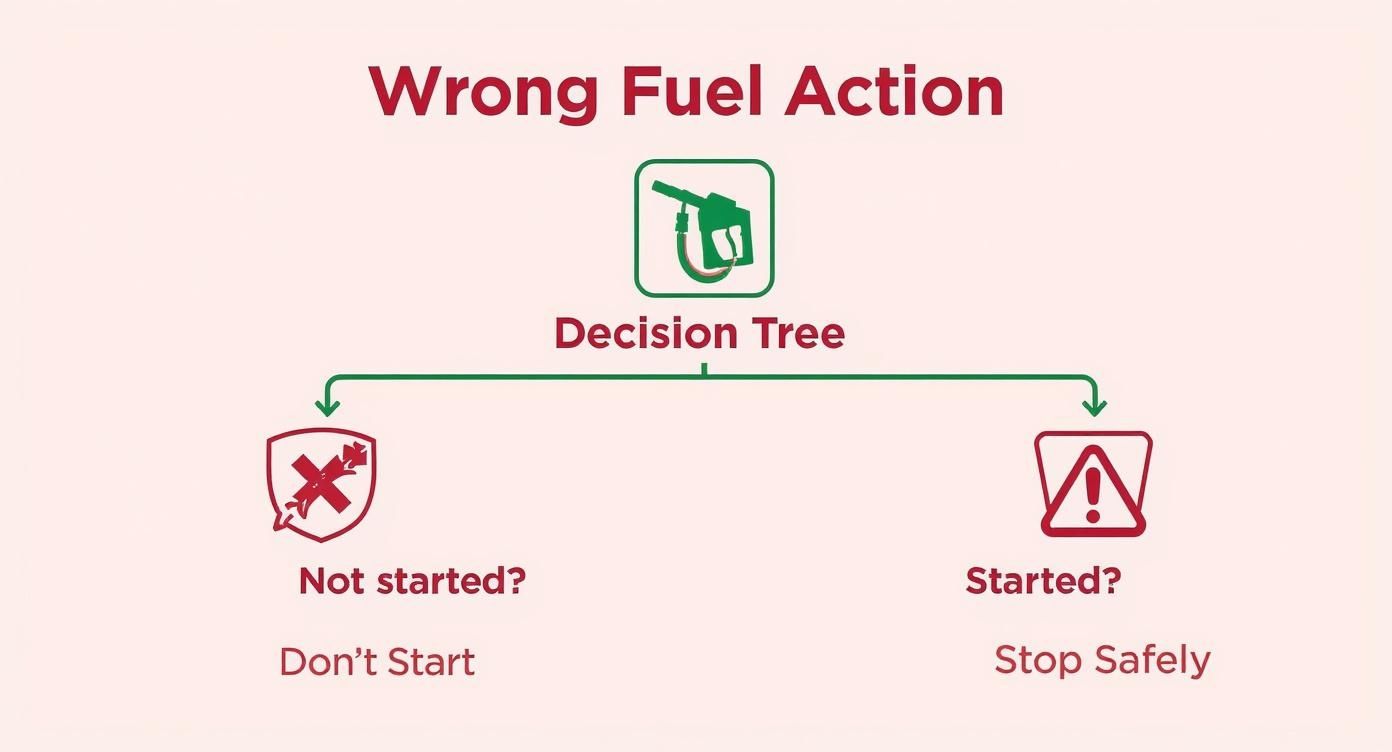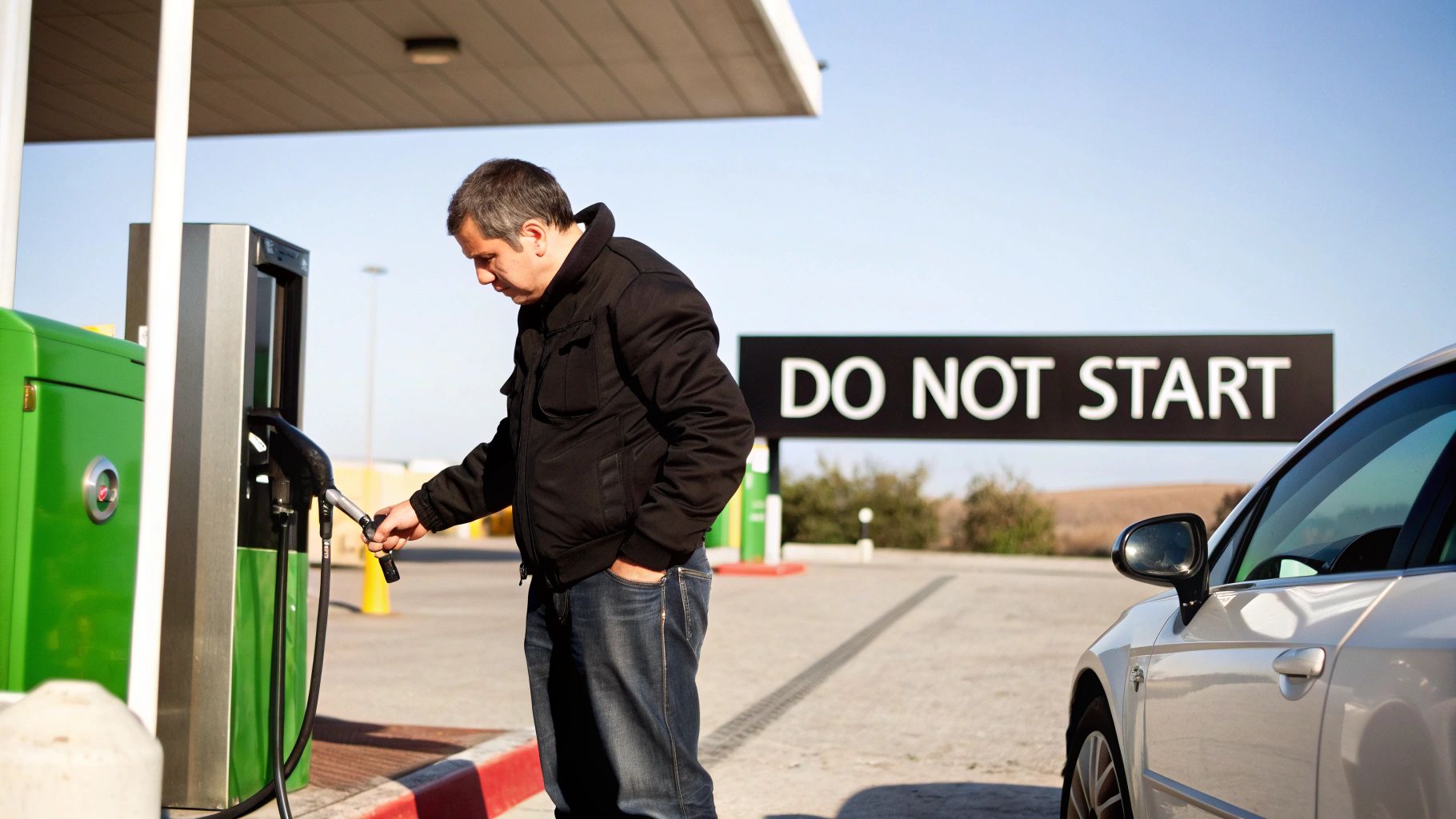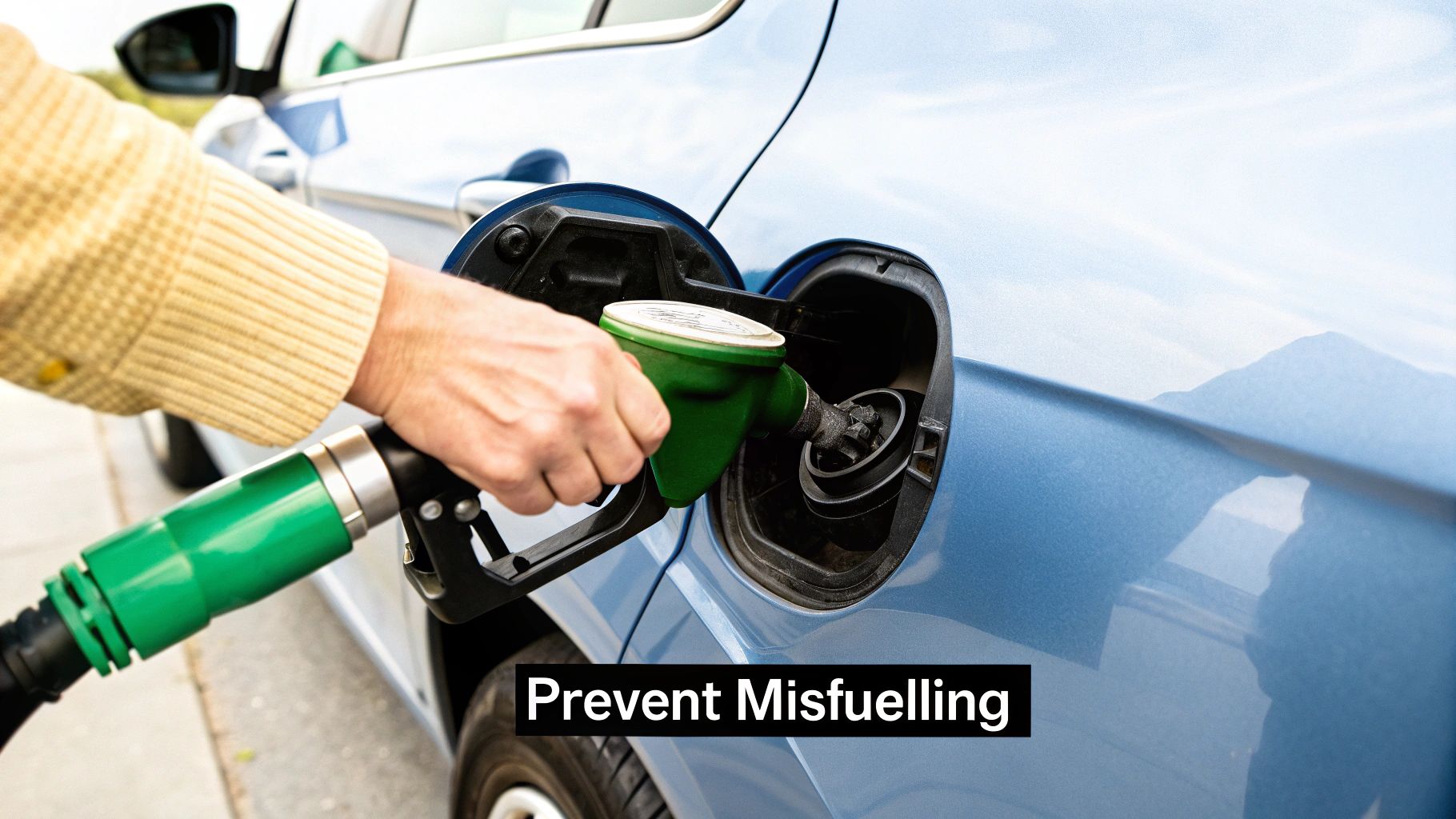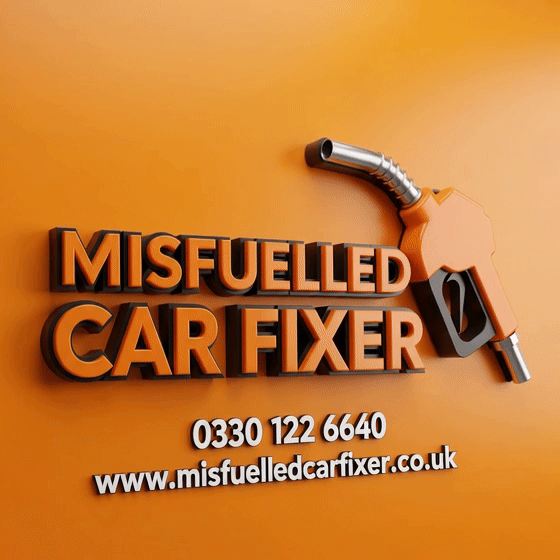Wrong Fuel in My Car A UK Driver's Guide
- Misfuelled Car Fixer

- Nov 12
- 13 min read
It’s a moment of sheer panic. You’ve just finished filling up, the nozzle clicks off, and you glance down to see you’ve grabbed the wrong one. That sinking feeling in your stomach is horrible, but the absolute most important thing to do right now is do not start the engine.
Don't even put the key in the ignition. Keeping the electrical systems off prevents the contaminated fuel from being pulled into the engine, which is your best defence against what could be thousands of pounds in damage.
What To Do Right There At The Petrol Station
First off, take a breath. You're not the first person to do this, and you certainly won't be the last. It's an incredibly common mistake, with estimates suggesting that around 150,000 drivers in the UK do it every single year. The most frequent slip-up is putting petrol into a diesel engine, which can cause some serious, and seriously expensive, damage if not handled correctly.
Your next few moves are vital for protecting your car's engine and fuel system from the worst of it.
Secure The Car, Secure Yourself
Your immediate priority is safety. If you haven't moved the car, leave it right where it is at the pump. If you absolutely have to move it out of the way, don't even think about starting it.
Pop the car into neutral and ask the petrol station staff or a fellow driver for a hand to push it into a safe parking spot.
Once you’ve moved it, make sure you:
Pull the handbrake on tight.
Switch on your hazard lights so other drivers can see you clearly.
Let the staff at the kiosk know what's happened.
This infographic lays out the situation perfectly – the outcome really hinges on whether or not you've turned that key.

The message is simple: keeping the ignition off is your best-case scenario. If you've already started the engine and driven off, pull over and stop as soon as it's safe.
Immediate Misfuelling Do's and Don'ts
When that moment of realisation hits, it's easy to panic. This quick table breaks down what you need to do—and what you must avoid.
Your Action | Why It's Critical |
|---|---|
DON'T start the engine. | This prevents the wrong fuel from circulating and causing costly damage to the engine and fuel system. |
DO inform the petrol station staff. | They need to know for safety reasons and may need to close the pump. |
DO put your car in neutral. | This allows you to push the vehicle to a safe spot without needing to start it. |
DON'T try to drain the fuel yourself. | Fuel is highly flammable and requires specialist equipment. It’s a job for trained professionals. |
DO call a wrong fuel specialist. | They have the right tools and expertise to drain the tank safely and get you back on your way. |
Following these simple steps can be the difference between a minor inconvenience and a major repair bill.
Who Should You Call For Help?
With the car safely parked and out of harm's way, your next call is to a professional wrong fuel recovery service. When you're stranded by an unexpected car problem, having the right number to call is essential, whether it's for a fuel drain or you need emergency car locksmith services to get you moving again.
Expert Tip: Whatever you do, don't be tempted to try and drain the tank yourself. Petrol and diesel are dangerous, flammable substances. Professionals have the specialised, sealed equipment to handle them safely and dispose of the contaminated fuel responsibly. A mobile fuel drain service is designed for exactly this situation.
Spotting the Signs: Petrol in Diesel vs. Diesel in Petrol

Realising you've put the wrong fuel in your car is a sinking feeling. But what happens next often depends on what exactly went into the tank. The signs your vehicle shows can be a dead giveaway, and believe me, not all fuel mix-ups are created equal.
Knowing how to read these symptoms is crucial. It helps you diagnose the problem quickly and give the recovery specialist the right information, which can make a huge difference in getting you sorted and back on the road.
Petrol in a Diesel Engine: The Classic (and Costly) Mistake
Putting petrol into a diesel car is by far the most common slip-up we see. Why? It’s a simple design flaw, really. The unleaded petrol nozzle is slimmer and slides right into the wider filler neck of most modern diesel cars without any trouble. Unfortunately, the consequences can be severe and show up almost immediately if you start the engine.
Think of diesel as an oily, lubricating fuel that keeps your high-pressure fuel pump and other sensitive parts running smoothly. Petrol, on the other hand, is a solvent. It does the complete opposite, stripping away that vital lubrication and causing metal components to grind against each other. It’s a recipe for disaster.
Here’s what you’ll likely experience:
A loud, metallic knocking sound from the engine. This is often the first, most alarming sign—it’s the sound of your fuel system components crying out in protest.
Billowing exhaust smoke. Expect to see plumes of white or grey smoke as the engine struggles to burn the wrong fuel mix.
A dramatic loss of power. The car will feel sluggish and weak, struggling to accelerate before eventually cutting out completely.
A dashboard lit up like a Christmas tree. Engine management and fuel system warning lights will almost certainly start flashing.
If you've put petrol in your diesel and driven off, pull over and stop the engine the second you realise something is wrong. Every moment it runs, you’re drastically increasing the risk of wrecking the fuel pump and injectors, which can easily lead to a repair bill in the thousands.
Diesel in a Petrol Engine: Less Common, Still a Problem
Putting diesel in a petrol car is a rarer mistake, mainly because the chunky diesel nozzle simply won't fit into the smaller unleaded filler neck on most cars. Still, it does happen, particularly with older vehicles or if someone isn't paying attention. The symptoms are quite different but will stop your journey just as effectively.
Diesel is far thicker and less flammable than petrol. A petrol engine is designed to ignite a fine, volatile mist of fuel with a spark plug. When it gets a gulp of thick, oily diesel, it just can't cope. You can learn more about what happens when diesel goes into a petrol car, but in short, the fuel clogs up the works.
The tell-tale signs are:
A rough, misfiring engine. The spark plugs get coated in oily diesel and can't create a proper spark, causing the engine to splutter and run erratically.
Black, smoky exhaust. This is the result of unburnt diesel being forced out of the exhaust system.
The engine will cut out. Your car might start and run for a very short time, but it will quickly stall and then refuse to restart once the diesel clogs the fuel lines and injectors.
AdBlue in the Fuel Tank: A Modern-Day Nightmare
A newer problem on the scene is accidentally pouring AdBlue into the diesel tank. AdBlue is a urea solution used in modern diesel cars to clean up exhaust emissions. It's not a fuel additive and has its own, usually blue, filler cap right next to the main one, making mistakes all too easy.
If AdBlue gets into your fuel system, it’s catastrophic. It’s highly corrosive to the seals, sensors, and pipes in your fuel system. Worse still, it can crystallise when it dries, causing rock-solid blockages that can destroy everything from the fuel pump to the injectors.
If you even suspect you've put AdBlue in the wrong place, do not turn the key. The damage can be immediate, extensive, and incredibly expensive to put right.
How a Professional Fuel Drain Service Works
So, you’ve made that dreaded call for help after putting the wrong fuel in your car. What happens now? You might picture a long, complicated process, but a mobile fuel drain is surprisingly efficient. It’s a precise, multi-step procedure designed to get you back on your way safely and with minimal fuss—it’s about far more than just sucking the fuel out.
When a qualified technician arrives, their first priority is safety. They'll assess the area, make sure your vehicle is secure, and take all the necessary precautions before touching a single tool. This always involves disconnecting the car's battery to eliminate any risk of sparks, a non-negotiable step when you’re dealing with flammable liquids.
The Draining and Flushing Process
Once the scene is secure, the real work begins. The technician will use specialised, ATEX-approved pumping equipment to remove the contaminated fuel. This certification is critical, as it guarantees the tools are safe for use in potentially explosive environments.
They'll access your fuel tank, usually through the filler neck or by removing the fuel sender unit, and start pumping the bad fuel mix into a secure, purpose-built container inside their van.
But the job doesn't stop there. A proper fuel drain means clearing the entire system. The technician will meticulously purge the contaminated fuel from every part of the line, including:
The fuel lines that run from the tank to the engine.
The fuel filter and its housing.
The fuel rail and, where possible, the injectors themselves.
After every last drop of the wrong fuel is removed, the system gets a rinse. The technician will flush it through with a small amount of clean, correct fuel, pushing out any lingering residue. This step is vital to ensure only pure fuel reaches your engine when you refill. For a closer look at the gear and safety protocols, take a look at our guide on how to drain a fuel tank safely.
Final Checks and Responsible Disposal
With the system flushed and clean, the technician will reconnect your battery, add a small amount of the correct fuel to your tank, and then start the engine. They’ll let it run for a few minutes, making sure everything is circulating as it should and that no warning lights pop up on the dashboard.
The entire on-site process is usually completed in under an hour. The goal is a swift, efficient fix that saves you from a much more expensive trip to the garage.
Finally, what happens to the contaminated fuel? It's securely stored for transport and disposed of responsibly. Reputable services adhere to strict environmental regulations. Understanding how to safely recycle old automotive oil gives you an idea of the rules involved. The hazardous waste will be taken to a licensed facility, giving you complete peace of mind that the job was done right from start to finish.
How Much is This Misfuelling Mistake Going to Cost?

After the initial panic of realising you’ve put the wrong fuel in your car, the next thought is almost always the same: "How much is this going to set me back?"
The answer really hinges on one single, critical action: whether or not you started the engine.
If you caught the mistake at the pump and left the keys out of the ignition, you can breathe a little easier. The fix is relatively straightforward and, more importantly, affordable. A mobile fuel drain is designed for this exact situation.
But if you started the car and drove off, even for a few metres, the financial picture can change drastically. This is where a simple slip-up can quickly become a very expensive problem.
The Cost of a Roadside Fuel Drain
Calling a mobile fuel drain specialist is, without a doubt, your most cost-effective option if the engine has stayed off. Generally, you can expect the price for this service in the UK to be between £150 and £300.
For that price, a technician comes to you and handles everything needed to get you safely on your way. The service typically includes:
An emergency call-out to your location (at the petrol station, work, or home).
Draining every last drop of the contaminated fuel from your tank.
Flushing the entire fuel system to clear any residue from the lines and filter.
Dealing with the safe, environmentally-compliant disposal of the mixed fuel.
Adding a small amount of the correct fuel to get your engine running and you to the nearest pump.
When you weigh it against the alternative, it's a small price to pay for a quick, professional fix. For a real-world example, see what happens after putting just 20 litres of petrol in a diesel car and how a fast response keeps costs down.
When Costs Spiral into the Thousands
The real financial damage starts the second you turn that key.
Circulating the wrong fuel, particularly petrol in a modern diesel engine, can cause catastrophic and immediate harm. Diesel acts as a lubricant for high-pressure fuel pumps and injectors. Petrol does the opposite; it's a solvent that strips away this vital lubrication, causing metal components to grind against each other.
This creates a domino effect of failures, and the repair bills can easily run into thousands of pounds.
A simple mistake at the pump can escalate from a £200 roadside fix to a £5,000+ engine rebuild if the car is driven. The damage often means replacing the fuel pump, all the injectors, filters, and sometimes even the fuel tank itself.
Will My Car Insurance Cover Misfuelling?
Here’s some bad news: most standard car insurance policies do not cover misfuelling. Insurers usually classify it as a self-inflicted error, putting it in the same category as running out of fuel or using the wrong type of engine oil. It's always worth digging out your policy documents and checking the list of exclusions.
Breakdown cover can be another grey area. Some top-tier plans from providers like the AA or RAC might offer misfuelling assistance as part of their package, but many basic policies won't. Before you call, check what your specific level of cover includes to avoid an unexpected bill. Your safest, and often fastest, bet is to call a dedicated fuel drain specialist directly.
How to Prevent Misfuelling Your Vehicle
The best way to deal with putting the wrong fuel in your car is, of course, to make sure it never happens. It’s a costly, stressful mistake that almost always comes down to one of three things: being distracted, being in a rush, or driving a car you’re not used to.
For most people, it's a simple lapse in concentration at the pump. Maybe you're thinking about the next meeting, listening to the kids squabbling in the back, or just running on autopilot after a long day. The single best defence you have is building a conscious routine for every time you pull up to refuel.
Simple Habits for Every Driver
Before you even grab the nozzle, just stop. Take a two-second pause. That tiny break is often all it takes to snap you out of autopilot and make you consciously check what you’re about to do. Double-check the label on the pump, the colour of the nozzle, and the sticker inside your fuel cap. They all need to match.
It’s also a great idea to cut out distractions. End that phone call before you even open the car door, and just focus on the task at hand until the cap is screwed back on tight. It sounds almost too simple, but these small shifts in behaviour make a massive difference.
The risk shoots up if you regularly swap between cars—say, a diesel work van and a petrol family car. If that's you, think about putting a brightly coloured, unmissable sticker inside the fuel flap as a final visual cue.
Good to Know: The classic misfuelling blunder is putting petrol into a diesel engine. This happens so often because the slimmer unleaded nozzle fits easily into the wider diesel filler neck. It's much harder to do it the other way around, as the chunky diesel nozzle just won't fit into most modern petrol cars.
Tools and Tech to Prevent Mistakes
If you want an extra layer of security, physical devices are a brilliant safety net. You can get special anti-misfuelling caps that are designed to physically stop you from making a mistake. They replace your car's standard cap and are engineered to only open for the correct sized fuel nozzle. Try to stick a petrol pump into a diesel tank with one of these fitted, and it simply won’t go in.
Here are a few gadgets worth looking into:
SoloDiesel Cap: A popular replacement cap that physically blocks the narrower petrol nozzle from entering a diesel tank.
Fuel Angel: This device sits inside the fuel neck itself, acting as a smart gatekeeper to stop the wrong fuel from ever getting in.
Colour-Coded Fuel Caps: A simple and cheap visual aid that helps you confirm you've got the right pump at a glance.
Strategies for Fleet Managers
If you're managing a fleet of vehicles, a single misfuelling incident is more than just an inconvenience. It can cause serious logistical headaches, vehicle downtime, and a hefty repair bill. Putting a clear prevention strategy in place isn't just a good idea—it's vital for keeping your operation running smoothly.
Start with clear, impossible-to-miss labelling in every single vehicle. A bold sticker on the dashboard, the sun visor, or right inside the fuel flap screaming "DIESEL ONLY" or "UNLEADED PETROL ONLY" is your first line of defence.
Back this up with proper driver training. Make misfuelling a specific topic during new vehicle handovers and regular safety briefings. By constantly reinforcing the risks and costs involved, you keep it front-of-mind for your drivers and protect your assets from a completely avoidable problem.
Your Misfuelling Questions Answered

When you're stood on a forecourt having just put the wrong fuel in your car, your mind is probably racing. It's a stressful moment, and a dozen questions pop into your head at once. We get calls every day from drivers in this exact situation, so we've put together answers to the most common queries we hear.
Will Just a Small Amount of Wrong Fuel Damage My Engine?
In short, yes. It's a question we get all the time, often from someone hoping a little bit won't hurt. But even a small amount of petrol in a modern diesel engine can cause serious, expensive damage.
The problem is that petrol acts as a solvent, stripping away the lubricating film that diesel provides. Your high-pressure fuel pump and injectors rely on that lubrication to work smoothly. Without it, metal grinds on metal, creating tiny fragments that get sent through the entire fuel system, wrecking sensitive components along the way.
Even a 5% petrol contamination in diesel can cause significant damage to the fuel pump and injectors. It's a gamble that's simply not worth taking with your vehicle's engine.
How Long Does a Mobile Fuel Drain Take?
A roadside fuel drain is usually a lot quicker than people think. You won't be stranded for half the day, waiting for a tow truck and a garage.
Once one of our technicians arrives, you can expect the whole process to take around 45 to 60 minutes. That typically includes:
Draining the contaminated fuel from your tank safely.
Flushing the fuel lines and filter housing to clear out any residue.
Putting in a small amount of the correct fuel to get you going again.
We aim to get you back on your journey with minimal fuss.
Is Misfuelling Covered By My Breakdown Service?
This is a big one, and the answer really depends on your specific policy. Many standard breakdown plans won't cover misfuelling because it's often classed as a self-inflicted error, not a mechanical breakdown.
However, many of the more comprehensive policies from providers like the AA, RAC, and Green Flag do include misfuelling assistance, either as part of the package or as a paid add-on. The best thing you can do is check your policy documents before you ever find yourself in this situation. That way, you know exactly who to call.
What Happens to the Contaminated Fuel After It's Drained?
We take our environmental responsibilities very seriously. The contaminated mix of petrol and diesel is classified as hazardous waste and must be disposed of correctly by law. It can't just be poured away.
Our technicians pump the mixed fuel into a secure, purpose-built container in their van. It’s then transported to a licensed waste management facility where it's processed and disposed of in an environmentally sound way. We can always provide the paperwork to show your waste fuel has been handled properly.
If you've put the wrong fuel in your car in Suffolk or the surrounding areas, don't panic and don't start the engine. Call Misfuelled Car Fixer for a fast, professional, and affordable 24/7 mobile fuel drain service. We'll get you safely back on the road. Contact us now.



Comments